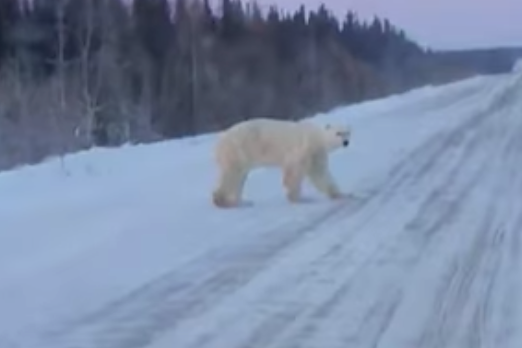Seeing polar bears considerably inland from Hudson Bay, as a Thompson resident did near Gillam Dec. 7, is not unprecedented, though perhaps unusual, and they may be sighted more frequently in the future as a result of the changing climate.
Lori Walsh and work colleagues saw a polar bear on Provincial Road 280 near Gillam early Wednesday morning as they were travelling back to Thompson. They captured video of the bear, which ambled across the road, paused briefly atop a snowbank to survey their vehicle and then went down across the ditch and off into the bush.
A spokesperson for the provincial government’s Natural Resources and Northern Development department the bear was captured Friday morning and “is being relocated to the Hudson Bay coastline, where it will be released and free to roam out onto the sea ice.”
Gillam is on the southern edge of polar bears’ usual roaming territory in Northern Manitoba.
Anyone who spots a polar bear can report it by calling the polar bear alert line at 204-675-2327(BEAR) or the TIP line at 1-800-782-0076.
This isn’t the first time that a polar bear has been spotted more than 100 kilometres from the shores of Hudson Bay this fall. In October, a bear was trapped in Shamattawa, which is further south than Gillam, at about the same latitude as Thompson and 130 kilometres south of York Factory, where the Nelson River enters Hudson Bay. That wasn’t the first time that a polar bear had visited the community, as one was also spotted on the shores of the river in Shamattawa in September 2010.
“”Such sightings used to be unusual,” says Ian Stirling, a retired Canadian Wildlife Service research scientist and adjunct professor in the University of Alberta Department of Biological Sciences, who is one of the world’s top authorities on polar bears and has studied the western Hudson Bay polar bear population extensively. He also said it is likely that more polar bears will be seen in inland areas over the coming years.
The reason for that is earlier melting of sea ice, which cuts into the bears’ prime feeding season from early April until ice breakup. Western Hudson Bay polar bears, says Stirling, take in about two-thirds of the stored energy they will need to fast for at least four months — eight months if they are pregnant — in the spring and early summer.
“The earlier the breakup, the progressively less time that bears have to feed during the most important time of the year,” he says. “This means that progressively more bears are coming ashore along the Manitoba coast lighter and lighter over time.”
In essence, changing climate is resulting in the bears trying to go the same length of time on smaller fat stores, which Stirling likens to trying to drive a car the same distance on three-quarters of a tank as you do on a full one.
“Subadult bears in particular are lighter and running low on stored energy before freeze-up occurs so they get hungrier and hungrier, and thus go looking for alternate food sources on land during the long summer-fall fasting period,” Stirling says. “Some, mainly subadult males, range farther away from the normal range. There are probably many more, some of which may have been seen but not reported. Similar observations have been made in northern Ontario and elsewhere such as the southern Beaufort Sea where the population is also in decline because of climate warming.”




